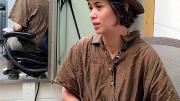In designing 106 costumes from scratch for the musical Finding Neverland, Suttirat Larlarb was challenged to depict Edwardian-era history with a fresh visual edge—and convey the explosive magic of the imagination. “You don’t want a museum piece set to music,” notes Larlarb, who was educated at Stanford and Yale. She has worked on numerous films (e.g., Slumdog Millionaire and Trance), and co-designed the 2012 Summer Olympics opening ceremony: recall the splendid “white-dove” cyclists? The ART’s world-premiere musical, based on the 2004 movie, has its own wings (for bumblebees), dancing servants, dogs, one mermaid, and a crew of sexy pirates. All contribute to the play’s modern meditation on the roots of creativity and the nature of youth, as evidenced in J.M. Barrie’s relationship with the Llewelyn Davies family as he conjures up Peter Pan. Backed by Hollywood producer Harvey Weinstein, Neverland is a sumptuous production that is likely headed to London or Broadway. Like the fantastical sets, Larlarb’s creations intensify the drama. Barrie’s society-minded wife, Mary, strides around in a silky, lace dress with a proper high neck, curve-loving bodice, and layers of ruffles too stiff to shimmy when she walks. (It was inspired by a 1901 dress at the Kyoto Costume Institute and a more recent design in Vogue Italia.)Even Mary’s satin evening gown is an “urban,” orderly, navy blue, Larlarb says, whereas her husband’s muse, Sylvia Llewelyn Davies, is a softer creature first seen playing in a park with her boys. She wears drapey, gauzy blouses and long skirts of pale oranges, pinks, and lavender—just “the right degree of bohemian hyperfemininity,” says Larlarb—and a peach-toned frock with an airy, flowery print at dinner. No matter how beautiful, the designer adds, costumes should not be signature artistic “concepts,” a word she dislikes. Instead, “they serve a larger ambition—the intended journey of the play.”
Finding Neverland at Harvard's American Repertory Theater
Finding Neverland at Harvard's American Repertory Theater
The ART launches a sumptuous world premiere of Finding Neverland


You might also like
Five Questions with Michèle Duguay
A Harvard scholar of music theory on how streaming services have changed the experience of music
Reese Witherspoon Visits Harvard—and Talks Women, Media, and AI
Reese Witherspoon discusses female-driven content at Harvard Business School.
A (Truly) Naked Take on Second-Wave Feminism
Playwright Bess Wohl’s Liberation opens on Broadway.
Most popular
Explore More From Current Issue

A Forgotten Harvard Anthem
Published the year the Titanic sank, “Harvard’s Best” is a quizzical ode to the University.

Getting to Mars (for Real)
Humans have been dreaming of living on the Red Planet for decades. Harvard researchers are on the case.

The Trouble with Sidechat
No one feels responsible for what happens on Harvard’s anonymous social media app.





